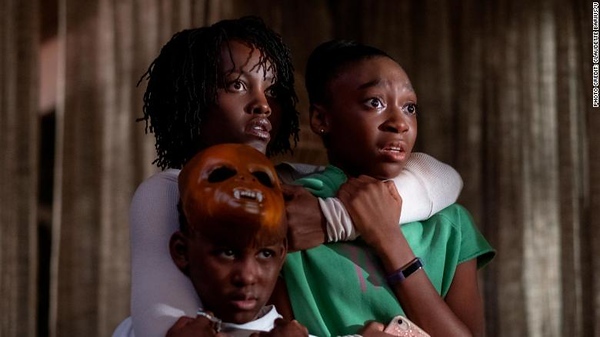Review: Us

Credit: Claudette Barius
Brought to audiences by the same director of the critically acclaimed “Get Out,” Jordan Peele presents “Us,” a unique horror film in which a family finds themselves attacked by their doppelgangers.
April 24, 2019
After delivering audiences the critically acclaimed 2017 social thriller Get Out, director Jordan Peele showcases Us, a unique horror film starring Lupita Nyong’o, Winston Duke, Shahadi Wright Joseph, Evan Alex, Elisabeth Moss and Tim Heidecker. Us follows members of a family who are confronted by their doppelgangers, and while the film presents the audience with an original idea that had a lot of potential, the poor execution of these ideas led to many plot holes and lazy writing which left me scratching my head.
The film begins in 1986, with Adelaide Thomas, one of the main characters, going on vacation in Santa Cruz. She separates from her family and enters a funhouse where she finds a doppelganger of herself who attacks her. When she returns to her parents, she is unable to speak.
The movie fast-forwards to Adelaide’s adulthood, where she is married and has two children. Adelaide returns to her beach house in Santa Cruz with her family despite the trauma she survived in her childhood. During the first night that the family stays at the house, four intruders enter the home and attack Adelaide’s family. The Wilsons eventually realize that the intruders are their doppelgangers, and they are eventually able to escape on the family boat. The Wilsons turn on the news to see that millions of doppelgangers, which call themselves “the Tethered”, have been murdering their original counterparts throughout the United States and have subsequently been joining hands together to form a human chain that spans across the whole country.
While it appears as if Us tries to emulate moves such as The Mist or Dawn of the Planet of the Apes in which the action follows government science experimentation gone-wrong, the film does not give a strong explanation of why “the Tethered” were created or why the experiment was abandoned which forced the government to store the clones in tunnels underneath the country. While the doppelganger idea had a large amount of potential in creating a good film, the backstory left the movie with more holes in it than a block of swiss cheese.
While the plot of the film was questionable, to say the least, and the twist at the end doesn’t make much sense, the first twenty minutes of the film was quite enjoyable. The cinematography and wardrobes were eye-catching, and the soundtrack and acting were superb. The first portion of the movie worked as a great build up to a great story that never came. As soon as the clones arrived into the film and began talking, the dialogue became very cheesy, and a weird cat-and-mouse game ensued, where the clones were supposed to kill their counterparts but were seemingly never able to, even when they had the perfect opportunity to do so.
What earns the film a small amount of redemption is the strong acting by the cast, most of which had to play two roles. The cinematography, soundtrack and set design were all incredible, and it seemed as if the movie had all the pieces to be successful. However, its underdeveloped writing resulted in a film that is far worse than Get Out. It seems as if the best thing about this movie was the trailer.
Rating: 4/10
Opinion articles written by staff members represent their personal views. The opinions expressed do not necessarily represent WSPN as a publication.





![Last Wednesday, the Wayland School Committee gathered to discuss a number of topics regarding the health curriculum and Innovation Career Pathway course. Another large topic of conversation was the ways to potentially mitigate distracting cell phone usage. "These [phones] are going to distract your learning and social relationships," Superintendent David Fleishman said. "That's concrete right there."](https://waylandstudentpress.com/wp-content/uploads/2025/06/Screenshot-2025-06-04-at-9.49.31 PM-1200x886.png)



























![Troy Hoyt finishes the Boston Marathon, running for the Hoyt Foundation. T. Hoyt is the son of Hoyt Foundation CEO Russ Hoyt.
“[Running a marathon] might seem like a big thing, when it’s presented to you at first, but if you break it up and just keep telling yourself, “Yes, you can,” you can start chipping away at it. And before you know it, you’ll be running the whole 26 miles, and you won’t even think twice about it.” T. Hoyt said.](https://waylandstudentpress.com/wp-content/uploads/2025/04/C36E8761-1CBB-452E-9DF2-543EF7B1095E_1_105_c.jpeg)












































